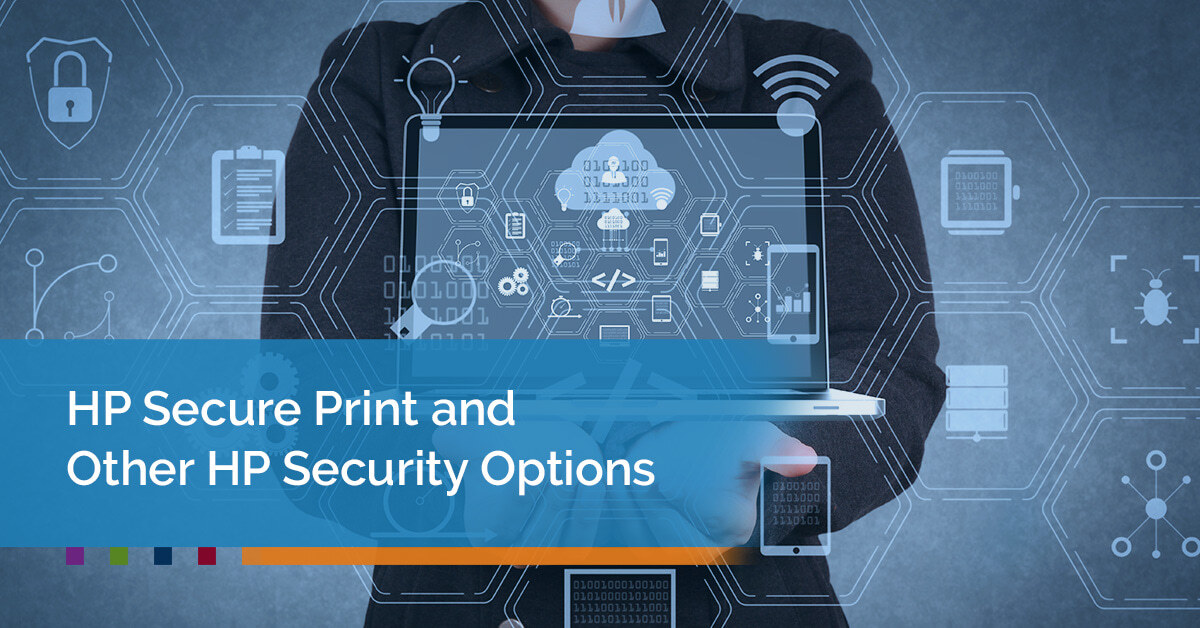HP Secure Print and Other HP Security Options
Maintaining a cutting-edge cybersecurity profile is a monumental task. Not only must you constantly work to secure mobile devices and individual workstations, but you must also address weak links in the chain in order to prevent future vulnerabilities from exploit.
In the world of cybersecurity, printers often take a backseat to other, apparently more threatening attack vectors in the office. But printers remain a weak link in most offices, and cybercriminals are keen on exploiting their weaknesses.
With the fact that both cybercriminals and cybersecurity professionals are in a full-scale arms race to adopt radically new technologies towards their goals, the case become clear. It is not enough to have “good” network security in your office. You need world-class security on-demand in order to reasonably expect to resist attack.
HP is well known for its comprehensive security solutions. Its profile is rising thanks to its cybersecurity-oriented web series The Wolf – a genius marketing strategy for a technology manufacturer. HP technology addresses some of the most important vulnerabilities in today’s technological environment.
5 Security Vulnerabilities HP Secure Print Addresses
Print security adds a dimension that neither workstation or mobile device security share. The fact that printers create physical documents is key to understanding the unique challenge that printer security presents.
HP identifies five specific areas to address:
1. Improper Device Configuration
Most printer users want their devices to work right out of the box. Printer manufacturers know this, so they set their devices to automatically accept incoming connections. The practical benefit of this approach is that customers enjoy plug-and-play functionality.
But this approach has a serious downside. If nobody configures the printer to accept only trusted incoming connections, it becomes an open door for cybercriminals to gain control of your print network.
2. Lack of Threat Detection
Workstations and network equipment typically feature anti-virus software, malware detection solutions, and a wide range of security-oriented monitoring and analysis features. Printers, on the other hand, are considered fully-featured if they can scan and copy documents.
HP’s security-oriented printers feature security monitoring solutions that rival some of the most comprehensive security programs on the market. HP Secure Print-enabled devices can automatically verify their own firmware upon startup, giving them the ability to detect and mitigate threats in real-time.
3. Lack of Data Categorization
For the average printer, there is no difference between a customer’s name and a customer’s social security number. If the printer does not support any kind of data categorization, it will automatically print any incoming document on command, regardless of who orders the print.
Organizations with clear data security policies have the ability to program their HP printers to automatically enforce print policy guidelines concerning sensitive information. Certain files and certain file formats can be set to only print with authorized user authentication.
4. Unencrypted Data
Because printers work with data, they have to hold data somewhere. Printer hard drives hold queues in place so that users can print large document orders without having to wait and individually print every page one at a time.
But when printers are often set to accept all incoming connections, this presents an important vulnerability. An attacker doesn’t need to infiltrate your network to steal documents and data from your organization – it’s all right there on the printer’s hard drive. Hard drive encryption is the best way to mitigate this risk and ensure that sensitive data is secure.
5. Access Control
Establishing a print policy that categorizes and encrypts data is key to protecting print fleets from network threats. However, printer security demands solutions for the physical dangers of creating paper documents.
Only printers that support secure user authentication stand a reasonable chance of preventing unauthorized individuals from obtaining sensitive documents. Employees leave documents in printer paper trays all the time – making them authenticate their prints with a PIN code or an RFID card is key to establishing best-in-class printer security.
Implement HP Secure Print in Your Organization
HP printers and multifunction devices feature built-in security features that address the most common vulnerabilities in office print networks. Automated security monitoring improves the ability for small businesses and enterprises alike to mitigate security threats effectively.
HP hardware also provides a robust platform for meeting the unknown, unidentified threats of tomorrow. HP releases regular updates to meet the latest cybersecurity threats, and empowers businesses to adopt defensive strategies that keep their most critical assets safe.
But making the most of HP technology requires world-class technical expertise. Your managed print service vendor is a key component of your overall security strategy, giving you access to professional consulting services informed by years of experience.
Secure your print networks with award-winning HP technology. Talk to a James Imaging System expert to get started


